A Guide to Growing and Cooking All Kinds of Mushrooms
Go beyond the basic grocery varieties and give oyster, maitake, lion’s mane, enoki and other fungi a try.
A Guide to Growing and Cooking All Kinds of Mushrooms
Go beyond the basic grocery varieties and give oyster, maitake, lion’s mane, enoki and other fungi a try.
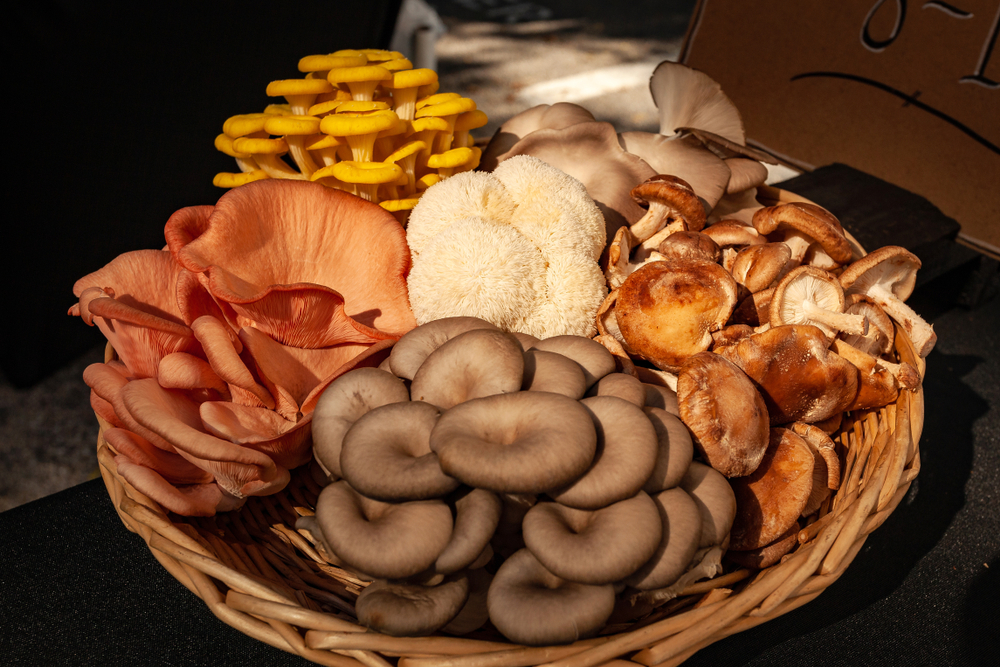
There's no portobellos in this basket!by John Wesolowski, Shutterstock.
The mushroom world is booming. Over the last several years, a growing network of homebound mycological enthusiasts, whether suffering from lockdown boredom, interested in the health benefits of fungi or eager to become more self-sufficient, has continued to spread.
The rise of at-home growing kits has presented new opportunities for home gardeners to easily expand beyond mainstream mushrooms found in grocery stores—which are less diverse than their labels hint at. You may not know it, but the button mushroom (or white mushroom), the cremini (also called baby bella) and the portobello are all the same species of mushroom, Agaricus bisporus.
But there’s a whole other world of flavors and textures available in edible mushrooms, which can be meaty and crispy, earthy and gamey or nutty and crunchy.
For those lacking the know-how on fungi, we’ve assembled a guide to how to grow and cook a wide variety of mushrooms.
First, some general information…
For starters, mushrooms grow from spores, not seeds, and these spores rely on substrate such as sawdust, grain, straw or wood chips for nourishment. A blend of the spores and these nutrient sources is called spawning substrate. Certain mushrooms prefer some substances to others. We have included this information in the options below.
For the most part, mushrooms also like dark, cool, humid environments, so growing them in a basement, closet or clean spaces under your kitchen sink are ideal. (We will specify if the mushroom has contrary needs.) Temperature and humidity throughout the growing process will vary, but if you’re new to mushroom cultivation, we suggest purchasing a grow kit as it will provide you with detailed instructions and materials you need to get started. If you’d like to get a thorough understanding of the general process from inoculation to harvest, check out this how-to.
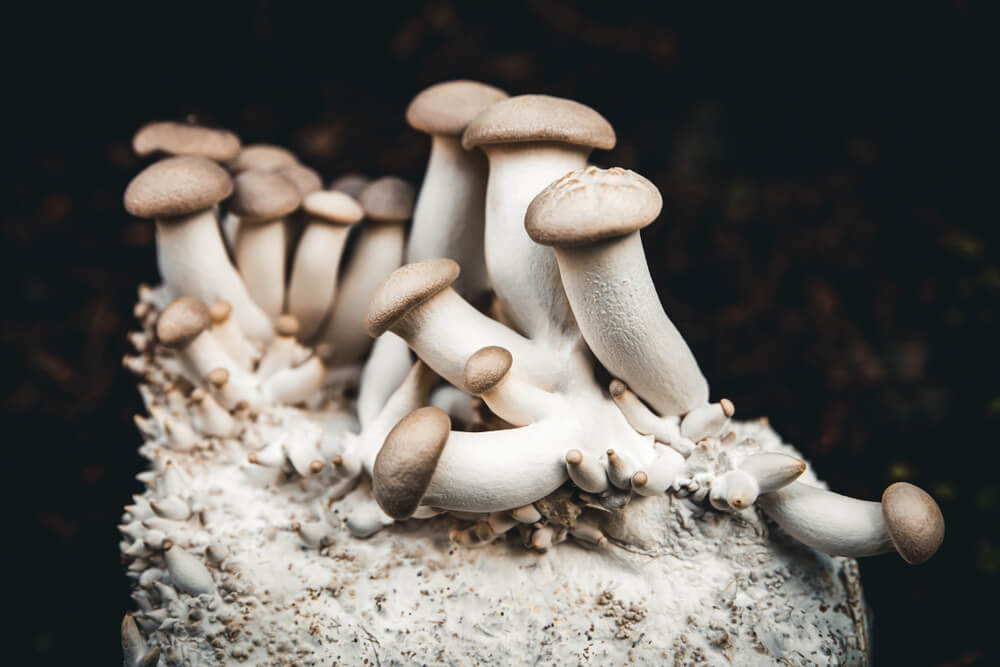
King Oyster
King oysters, also known as the king trumpet mushroom or eryngii, are the largest mushrooms in the oyster family. These mushrooms are native to the Mediterranean regions of Europe, the Middle East and Africa, but they are also cultivated widely throughout Asia. They are packed with protein, thiamin, vitamin B6, folate, iron, magnesium, zinc and manganese.
How to grow: King oysters take on average two months to grow, but once they start pinning, they’re ready to harvest within a week. They sprout up best on supplemented hardwood sawdust in grow bags. It’s been reported that they maintain a longer shelf life if grown on hardwood sawdust rather than straw. Cultivators also report that the king oyster will have a longer shelf life and a better texture if grown on hardwood sawdust rather than straw. Ideal incubation temperature is between 68°F and 72°F, pinning should happen around 59°F (humidity 95 percent), with fruiting temperatures from 59°F to 65°F (humidity above 80 percent).
Harvest time for king oysters depends on your own preference. Smaller, younger mushrooms will generally have a better texture and flavor, but you’ll have less to harvest. A good rule of thumb, however, is to harvest as the cap starts to flatten. When harvesting, cut these mushrooms at the base of the stem.
How to cook and eat: These mushrooms have a nutty, umami flavor and meaty texture. There is a variety of recipe routes you could take. To play up its umami taste, these soy butter glazed mushrooms are a great option. As meat alternatives, they can be a great substitute for scallops, when their stems are sliced into rounds, or pulled pork, when shredded and seasoned.
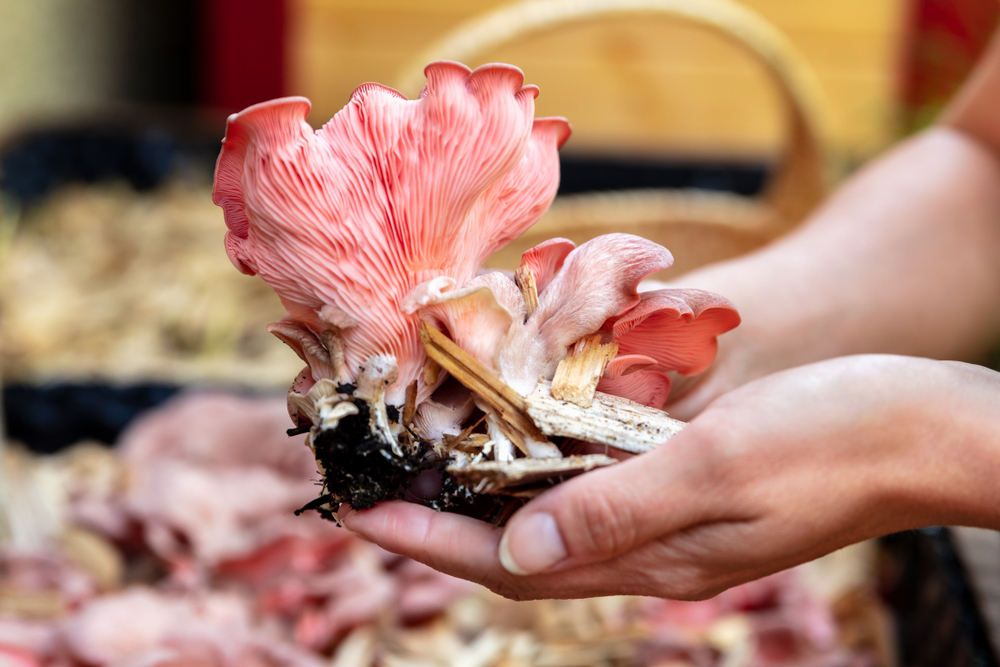
Pink Oyster
The pink oyster mushroom grows a thin curly cap, roughly three quarter inches to two inches in diameter. This mushroom, native to the topics, is prized for its bright coral color and ruffled appearance—although this shade quickly fades once cooked. It is high in protein, vitamin B, amino acids and has been shown to have antioxidant properties and lower cholesterol.
How to grow: Straw is often said to be the best substrate, and it allows these mushrooms to colonize quickly. Grain also works well. This could include rye or millet. Incubation and pinning should occur at a temperature between 73°F and 100°F, with fruiting occurring at temperatures between 68°F and 86°F (humidity 85 percent or greater).
On average, it takes about three to four weeks for them to become harvestable. You can harvest these before the cap curls up. You can cut them off in clusters to promote future sprout-ups if you’re growing on a block or piece of wood.
How to cook and eat: Pink oysters have a short shelf life and should be consumed within two days after harvesting. You will notice when they start to spoil as they take on a urine-like scent (yikes). At their best, however, pink oyster mushrooms have been described as meaty in taste, and like their other oyster mushroom cousins, are packed with umami. When fried, they can be used as a vegetarian alternative to ham or bacon. Make sure you fully cook them or else you’ll be left with a slightly sour flavor. You’ll know they’re fully cooked when they turn a bright golden shade. Try this pink oyster mushroom quiche, these imitation bacon bits and this rigatoni with pink oyster mushrooms and peas.
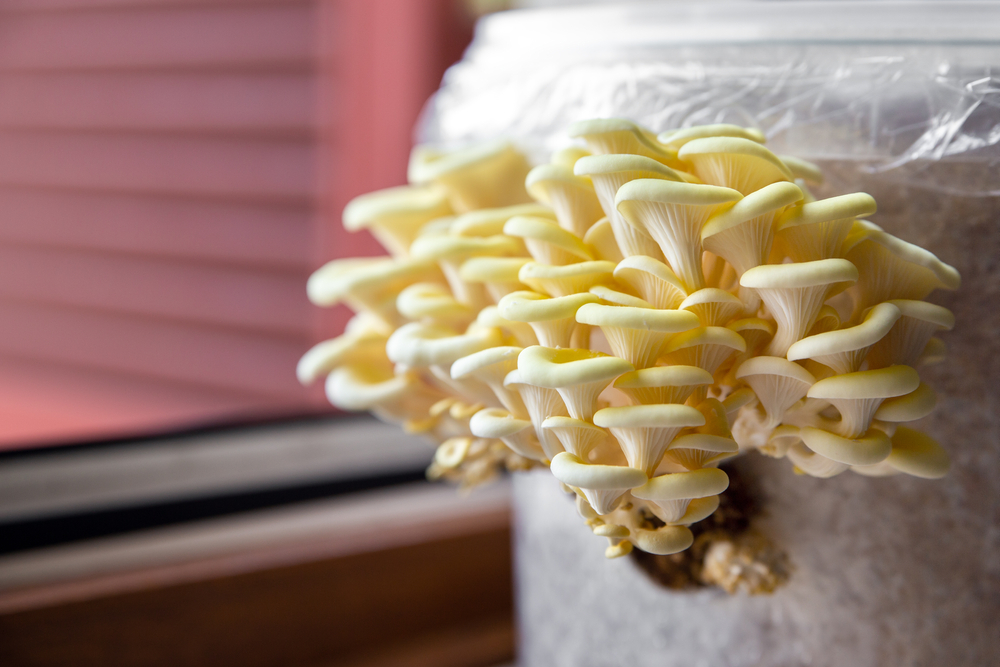
Yellow Oyster
Yellow oyster, or golden oyster mushrooms, grow caps averaging a half an inch to two inches in diameter. Their petal-like clusters are attached to a short or rather invisible stem and are native to eastern Russia, northern China and Japan. They’re a source of potassium, vitamins B2, B3 and B5 and also high in protein.
How to grow: Rye grain, sorghum or millet are ideal options for substrate when growing these mushrooms indoors. However, straw or supplemented sawdust are also acceptable. The ideal temperature range is from 68°F to 86°F. The incubation temperature should be above 79°F. Pinning periods should have a temperature around 59°F (humidity nearly 100 percent). When fruiting, you can bring the temperature back up to what it was at incubation (humidity 80 to 95 percent).
These mushrooms need a well-lit space to grow, as brightness of the gold cap color is directly related to the intensity of light, but do not expose them to direct sunlight.
These mushrooms have a reputation for being beginner friendly and are popular selections for at-home mushroom growing kits. They’re also one of the faster-growing types. On average, it takes five to six weeks before fruiting occurs, with harvesting about five to 10 days after initial fruiting. When it’s harvest time, you can remove the entire cluster of the mushroom by cutting it off with a knife at the base. This will be when the caps flatten but before they curl upwards.
How to cook and eat: Yellow oyster mushrooms have a slightly bitter taste that only disappears when cooked. We also suggest removing any stems in sight as they can also be unpleasantly bitter. Yellow oysters have a short shelf life and should be eaten within two days of being harvested.
The taste is best after the mushroom is cooked crispy or for at least 15 minutes. At this point, it will develop a cashew-like flavor. Some people transform it into a vegan version of bacon. These mushrooms are versatile and can be cooked in soups, mixed into sauces, cooked into omelets, sprinkled over pizza or served on toast, like this pairing with Brie cheese, for instance.
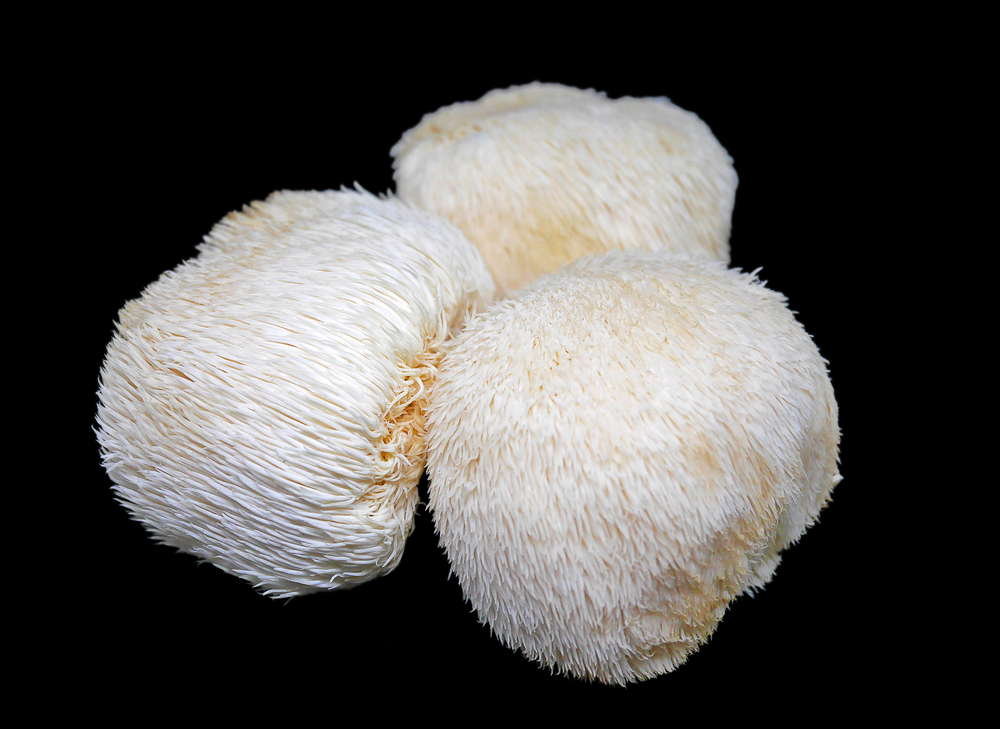
Lion’s Mane
Lion’s mane mushrooms, native to Asia, Europe and North America, are large, white, fluffy and bulbous mushrooms that resemble a shaggy lion’s mane as they develop. They can grow to be quite large, weighing more than one pound. Scientists have extensively studied this mushroom to understand its health benefits. Research has suggested that lion’s mane is good for neuro-health. Other papers have pointed to its ability to provide an immune system boost.
How to grow: If growing lion’s mane indoors in bags or containers, you could be harvesting as early as one month after inoculation. We suggest using hardwood sawdust as a substrate. Some have reported supplementing this with 10 to 20 percent wheat bran and achieving more growth. It takes about two to three weeks for the mycelium to spread throughout your substrate. Anywhere between seven and 10 days later, you should have mushrooms that are ready to harvest.
It’s important to note that lion’s mane is vulnerable to bruising, and if their spines get damaged or the mushrooms get old, they start to turn brown. Incubation should be at room temperature, pinning should occur at temperatures around 59°F and fruiting between 59°F and 68°F (humidity 90 percent).
How to cook and eat: Many have described lion’s mane as having a seafood-like flavor, with a stringy, meaty texture similar to lobster or crab. It’s also commonly used as a vegan substitute for liver. If interested in making it a seafood substitute, try these lion’s mane “crab” cakes. This liver-and-onions spin-off dish with sherried shallots and roasted lion’s mane is another option. In the mood for soup? Check out this broccoli and potato recipe for inspiration.
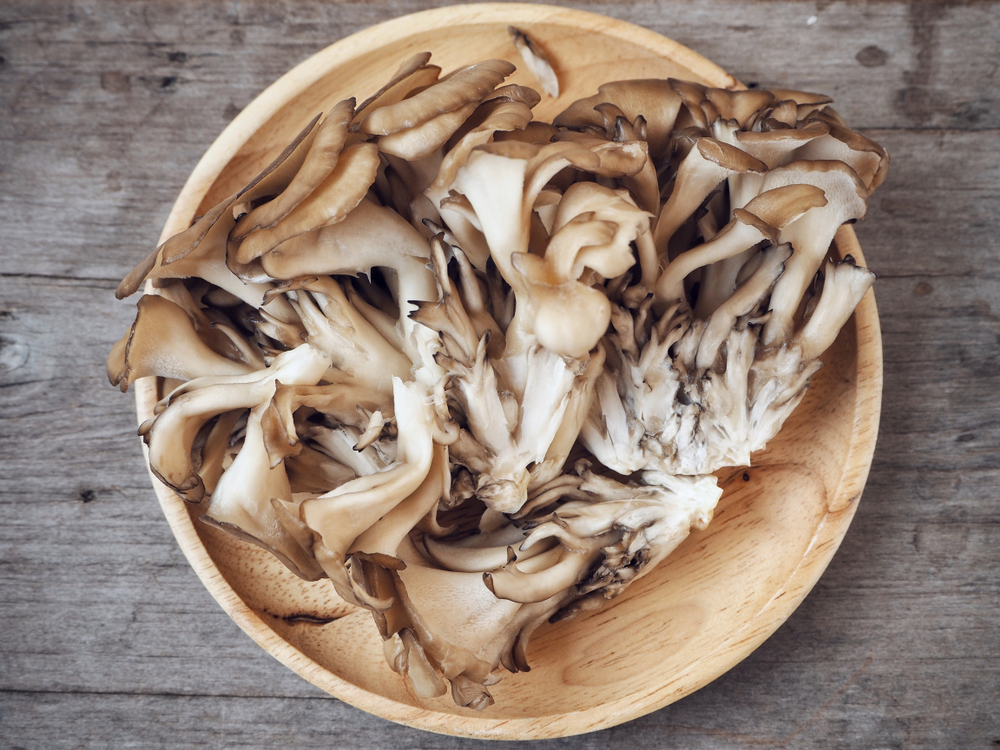
Maitake
Maitake mushrooms, also known as Hen of the Woods, are native to China and Japan. These mushrooms grow in clusters of flattened caps, which can be four to six inches in diameter and weigh anywhere from three to 15 pounds. Maitake mushrooms contain beta-glucan, a compound linked to reducing cholesterol, improving artery function and reducing risk for heart disease. They’re also a source of antioxidants, vitamin B and C, potassium and fiber.
How to grow: Choose a place that is shaded but not entirely without access to light. We recommend using sawdust as a substrate for this mushroom. It prefers a temperature between 60°F and 70°F (humidity between 60 and 65 percent). These mushrooms are slow growing, taking approximately three to four months to reach maturity when growing indoors. Maitake is also more susceptible to contamination, so ensure you’re growing in a clean environment.
You can harvest these mushrooms as early as when the caps grow to be about two inches in diameter. Use a clean, sharp knife to cut your mushrooms at the base.
How to cook and eat: Your maitake mushrooms can last up to two weeks if stored properly in the refrigerator. Despite being valued as a versatile mushroom, maitake has been described as having a stronger earthy, peppery taste compared to the other options on this list. Bon Appétit has this list that showcases six different ways to use them in a dish. The spread consists of everything from a swiss chard and mushroom galette to a prosciutto-stuffed chicken with mushroom sauce to a mushroomy fried farro with pickled carrots and runny eggs.
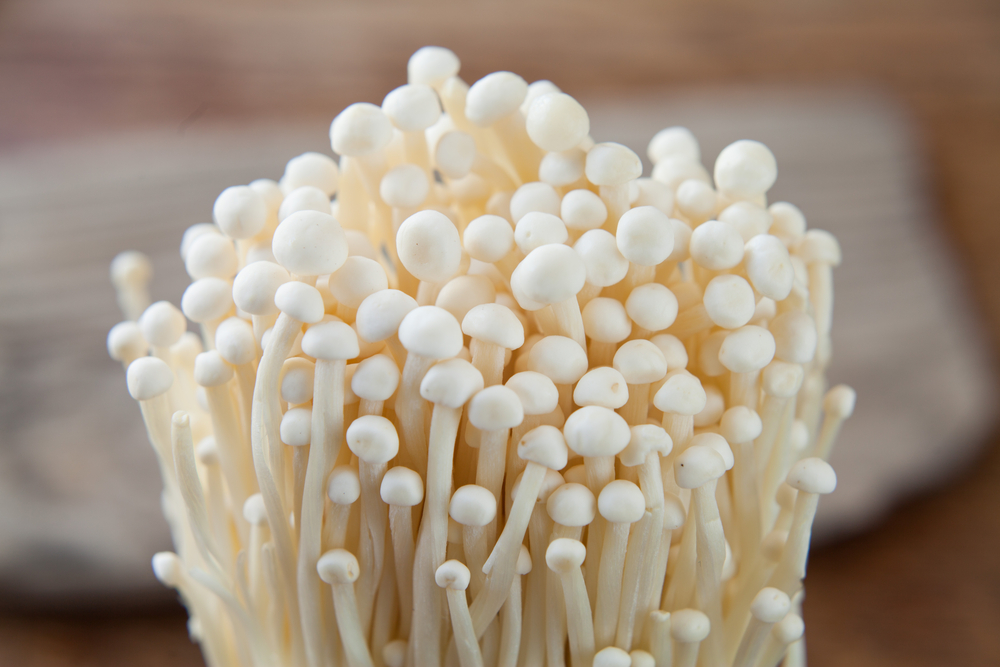
Enoki
Enoki, also known as velvet shank, are native to Eastern Asia and North America.
These mushrooms are recognizable for their distinctive noodle-like shape, with tiny caps at the top. Like many of the other options on this list, they are a great source of fiber and packed with B vitamins, which includes niacin, pantothenic acid and thiamine. As an antioxidant, scientists have also been studying potential cancer-fighting properties and their ability to block the growth of cancer cells.
How to grow: These mushrooms grow best in hardwood sawdust, but straw or garden compost can also be used as a substitute. During its incubation period, temperature should be between 72°F and 77°F (humidity around 80 percent). Once the mycelium strands appear, you can take it to a location where temperatures are between 50°F and 65°F. Pinning temperatures should sit around 60°F to 65°F. Fruiting temperatures can be at the incubation range or even a few degrees lower.
It takes about a month for these mushrooms to be ready to harvest. You can do so by cutting the stems off from the base with a sterilized knife.
How to cook and eat: Enoki mushrooms stand out for their crunchy texture. After harvest, they can stay fresh for about two weeks if you refrigerate them. These mushrooms have a flavor that’s been described as delicate and savory, compared to meatier oyster mushrooms or earthy shiitake mushrooms. Enoki mushrooms are commonly used in Asian dishes, and they can be eaten raw, cooked in soups or sautéed. Try this enoki mushroom stir-fry with ginger, lime and loads of garlic. Bacon-wrapped enoki in a maple-sake glaze is another option. If you’d like to try them raw, check out this salad.
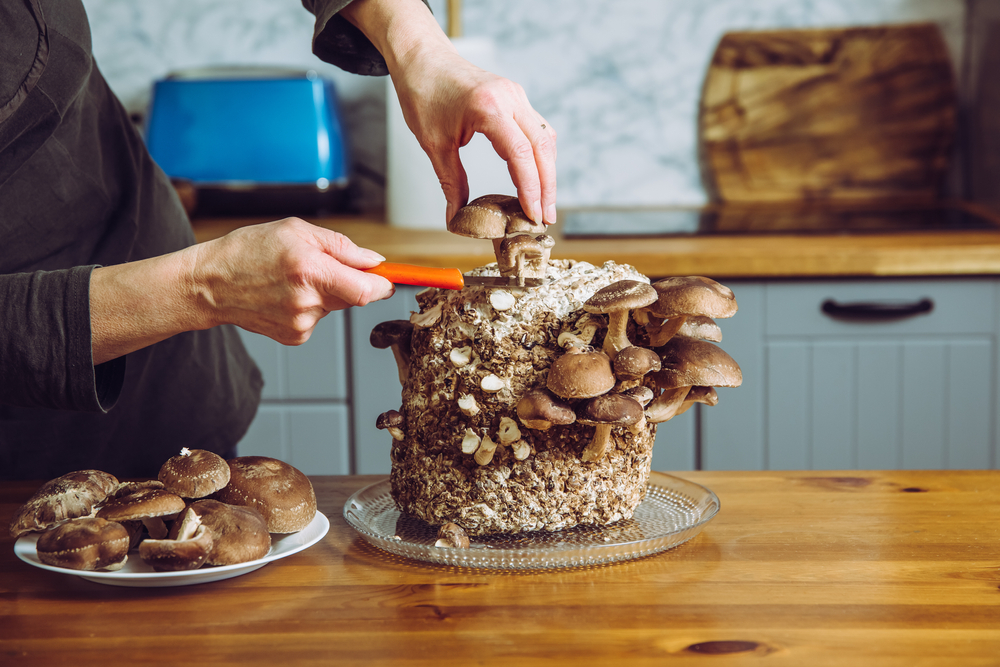
Shiitake
Shiitake mushrooms, native to East Asia, are high in protein, vitamin B, vitamin D and dietary fiber. They provide a number of flavonoids, known for their anti-inflammatory benefits. They contain eritadenine, which is known for reducing cholesterol. These mushrooms have an umbrella-like cap that grows to be three to six inches in diameter.
How to grow: These mushrooms are slightly more difficult to grow than oysters. This is because their mycelium is not as aggressive and they require a longer amount of time to incubate. You should have mushrooms anywhere between six to 12 months after inoculation.
In terms of substrate, we suggest going with a wood-based medium. This would include sourcing blocks of sawdust or sawdust pellets for indoor growers. Oak, maple, beech and ironwood are all great options. Room temperature or slightly above is fine for incubation, but colder temperatures from 37°F to 41°F are needed for pinning (humidity around 95 to 100 percent). For fruiting periods, 64°F or higher (humidity around 80 percent) is ideal.
Harvest your shiitakes any time before their caps flatten. You do this by taking a clean knife and cutting them at the base of their stem. It’s important to note that when they flatten out and then release spores, they’re no longer good for eating.
How to cook and eat: Shiitakes are described as having an earthy, rich and buttery flavor. While they are most often used as a focal point in Asian dishes, like these Chinese braised mushrooms, they are a pretty versatile mushroom and can be sautéed or thrown in stir-fries. In their dehydrated form, they can enhance the flavor of broth in a soup or stew. Interested in drying out your mushrooms? Check out our dehydrating how-to.
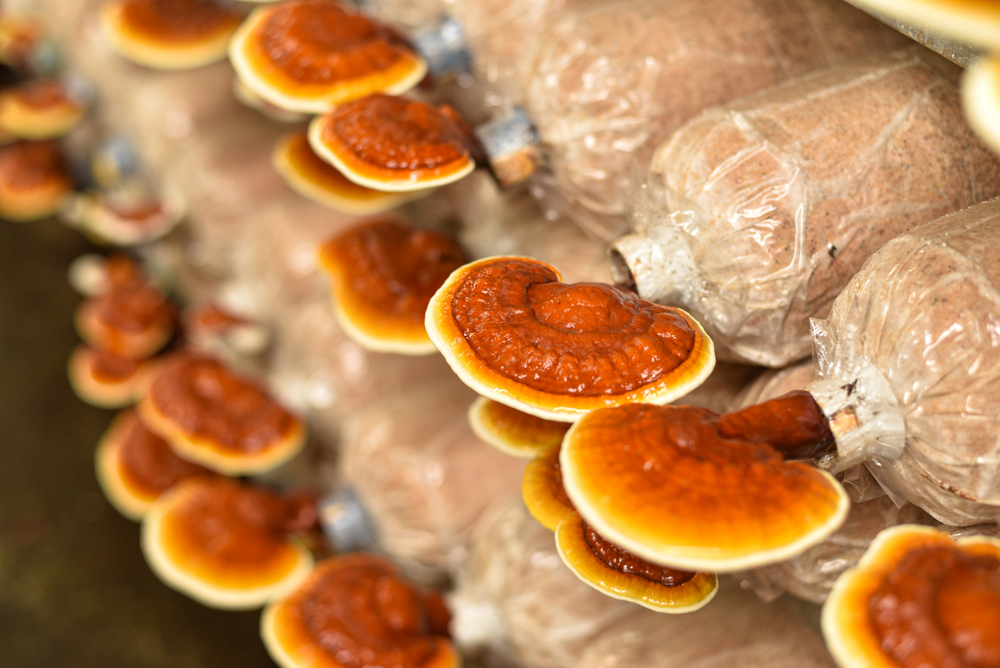
Reishi
Reishi mushrooms, otherwise known as lingzhi mushrooms, grow finger-like stalks called antlers. These antlers have a lacquered layer and develop to be a red to rust-brown color with yellow, tan or white at their growing tip. When mature, they flatten out and look like little fans.
They have a long history of being consumed to promote good health in China, Japan, Korea and other Asian countries. They contain triterpenoids, compounds linked to anti-inflammatory, analgesic and sedative effects. They’re also a source of fiber, calcium, potassium, iron, zinc and amino acids.
How to grow: For indoor growers, we suggest using a hardwood sawdust block (usually found in grow kits), rye or another grain as a substrate. You’ll also want large autoclavable grow bags, for when these ones begin to fruit.
It can take up to 30 to 45 days for reishi mushrooms to fully mature and form full antlers. Keep them out of direct sunlight. These mushrooms can sit at room temperature (68°F to 77°F) during incubation. Pinning should occur around 64°F (humidity 95 percent). Fruiting is ideal at room temperature once again (humidity 85 to 90 percent).
You can harvest when the antlers are only a few inches tall or allow them to grow for months and enjoy the unique shapes that develop. When you decide you’re ready to cut them loose, you can use a serrated knife to slice them off.
How to cook and eat: Unfortunately, this mushroom is not a top choice among culinary crowds due to its woody, bitter taste. But because of its perceived health benefits, the reishi mushroom is a popular ingredient added to teas and smoothies after it is dried and/or ground down once dehydrated. Try this reishi golden milk nightcap, reishi tea you can make in your slow cooker or, if you’re feeling up for it, try this reishi ramen bowl.
Follow us

This work is licensed under a Creative Commons Attribution-NoDerivatives 4.0 International License.
Want to republish a Modern Farmer story?
We are happy for Modern Farmer stories to be shared, and encourage you to republish our articles for your audience. When doing so, we ask that you follow these guidelines:
Please credit us and our writers
For the author byline, please use “Author Name, Modern Farmer.” At the top of our stories, if on the web, please include this text and link: “This story was originally published by Modern Farmer.”
Please make sure to include a link back to either our home page or the article URL.
At the bottom of the story, please include the following text:
“Modern Farmer is a nonprofit initiative dedicated to raising awareness and catalyzing action at the intersection of food, agriculture, and society. Read more at <link>Modern Farmer</link>.”
Use our widget
We’d like to be able to track our stories, so we ask that if you republish our content, you do so using our widget (located on the left hand side of the article). The HTML code has a built-in tracker that tells us the data and domain where the story was published, as well as view counts.
Check the image requirements
It’s your responsibility to confirm you're licensed to republish images in our articles. Some images, such as those from commercial providers, don't allow their images to be republished without permission or payment. Copyright terms are generally listed in the image caption and attribution. You are welcome to omit our images or substitute with your own. Charts and interactive graphics follow the same rules.
Don’t change too much. Or, ask us first.
Articles must be republished in their entirety. It’s okay to change references to time (“today” to “yesterday”) or location (“Iowa City, IA” to “here”). But please keep everything else the same.
If you feel strongly that a more material edit needs to be made, get in touch with us at [email protected]. We’re happy to discuss it with the original author, but we must have prior approval for changes before publication.
Special cases
Extracts. You may run the first few lines or paragraphs of the article and then say: “Read the full article at Modern Farmer” with a link back to the original article.
Quotes. You may quote authors provided you include a link back to the article URL.
Translations. These require writer approval. To inquire about translation of a Modern Farmer article, contact us at [email protected]
Signed consent / copyright release forms. These are not required, provided you are following these guidelines.
Print. Articles can be republished in print under these same rules, with the exception that you do not need to include the links.
Tag us
When sharing the story on social media, please tag us using the following: - Twitter (@ModFarm) - Facebook (@ModernFarmerMedia) - Instagram (@modfarm)
Use our content respectfully
Modern Farmer is a nonprofit and as such we share our content for free and in good faith in order to reach new audiences. Respectfully,
No selling ads against our stories. It’s okay to put our stories on pages with ads.
Don’t republish our material wholesale, or automatically; you need to select stories to be republished individually.
You have no rights to sell, license, syndicate, or otherwise represent yourself as the authorized owner of our material to any third parties. This means that you cannot actively publish or submit our work for syndication to third party platforms or apps like Apple News or Google News. We understand that publishers cannot fully control when certain third parties automatically summarize or crawl content from publishers’ own sites.
Keep in touch
We want to hear from you if you love Modern Farmer content, have a collaboration idea, or anything else to share. As a nonprofit outlet, we work in service of our community and are always open to comments, feedback, and ideas. Contact us at [email protected].by Lindsay Campbell, Modern Farmer
March 19, 2022
Modern Farmer Weekly
Solutions Hub
Innovations, ideas and inspiration. Actionable solutions for a resilient food system.
ExploreExplore other topics
Share With Us
We want to hear from Modern Farmer readers who have thoughtful commentary, actionable solutions, or helpful ideas to share.
SubmitNecessary cookies are absolutely essential for the website to function properly. This category only includes cookies that ensures basic functionalities and security features of the website. These cookies do not store any personal information.
Any cookies that may not be particularly necessary for the website to function and are used specifically to collect user personal data via analytics, ads, other embedded contents are termed as non-necessary cookies.
Thanks, this information and instruction is priceless